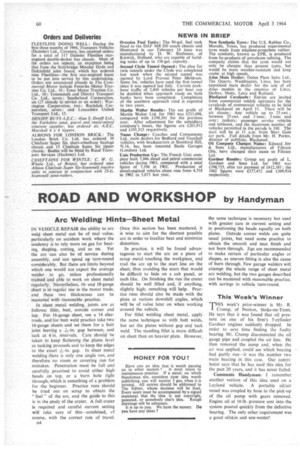ROAD AND WORKSHOP by Handyman
Page 62

If you've noticed an error in this article please click here to report it so we can fix it.
Arc Welding Hints—Sheet Metal
IN VEHICLE REPAIR the ability to arc weld sheet metal can be of real value, particularly on accident work where the tendency is to rely more on gas for heating, shaping, cutting, and so on. Yet the arc can also be of service during assembly, and can speed up turn-round considerably. But there are limits beyond which one would not expect the average welder to go, unless professionally trained and able to work on sheet metal regularly. Nevertheless, 16and 18-gauge sheet is in regular use in the motor trade, and these two thicknesses can be mastered with reasonable practice.
In sheet metal welding, joints are as follows; fillet, butt, outside corner and lap. For 16-gauge sheet, use a 14 electrode, and for butt weld practice take two 16-gauge sheets and set them for a butt joint leaving a s-in. gap between, and tack at 4 in. intervals. Care should be taken to keep flattening the plates level as tacking proceeds and to keep the edges to the exact gap. In sheet metal welding there is only one single run, and therefore no room or covering run for mistakes, Penetration must be full and carefully practised to avoid either high beads on top, or a burn hole right through, which is something of a problem for the beginner. Practice runs should be tried out on scrap to obtain the " feel " of the arc, and the guide to this is in the study of the crater. A full crater is required and careful current setting will take care of this—combined, of course, with the correct rate of travel,
D4 Once this section has been mastered, it is wise to aim for the shortest possible arc in order to localize heat and minimize distortion.
lin practice, it will be found advantageous to start the arc on a piece or scrap metal touching the workpiece, and trail the arc up to the start line on the sheet, thus avoiding the scars that would be difficult to hide on a cab panel, or such like. On finishing the run the crater should be well filled and, if anything, slightly high; remelting will help. Practice runs should also be made with the plate at various downhill angles, which will be of value later on when working around the vehicle.
For fillet welding sheet metal, apply the same technique as with butt welds, but set the plates without gap and tack weld. The standing fillet is more difficult on sheet than on heavier plate. However, the same technique is necessary hut used with greater care in current setting and in positioning the beads equally on both plates. Outside corner welds are quite usual joints, but need some practice to obtain the smooth and neat finish and not burn through. Jigs are recommended to make certain of particular angles or shapes, as uneven fitting is also the cause of burn through. Few garage welders will attempt the whole range of sheet metal arc welding, but the two gauges described can be mastered with reasonable practice, with savings in vehicle turn-round.
This Week's Winner THIS week's prize-winner is Mr. R. I Crump, of Norton, Stoke-on-Trent. He says that it was found that oil pressure on one of his firm's 5-cylinder Gardner engines suddenly dropped. In order to save time finding the faulty bearing Mr. Crump disconnected the oil gauge pipe and coupled the air line. He then removed the sump and, when the air was applied, could see which bearing had partly ran—it was the number two main bearing in this ease. Our contributor says that he has used this idea for the past 20 years, and it has never failed.
Comments Handyman: remember another version of this idea used on a Leyland vehicle. A portable oil/air vessel was coupled by hose to the pick-up of the oil pump with gears removed. Engine oil at 10 lb. pressure sent into the system poured quickly from the defective bearing. The only other requirement was a good oilskin and sou-wester!












































































































































